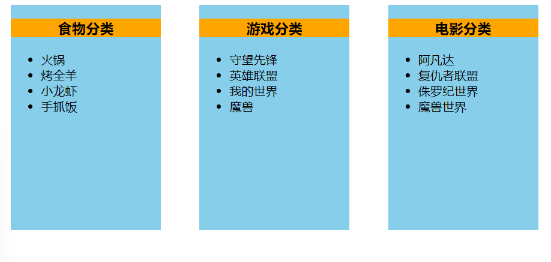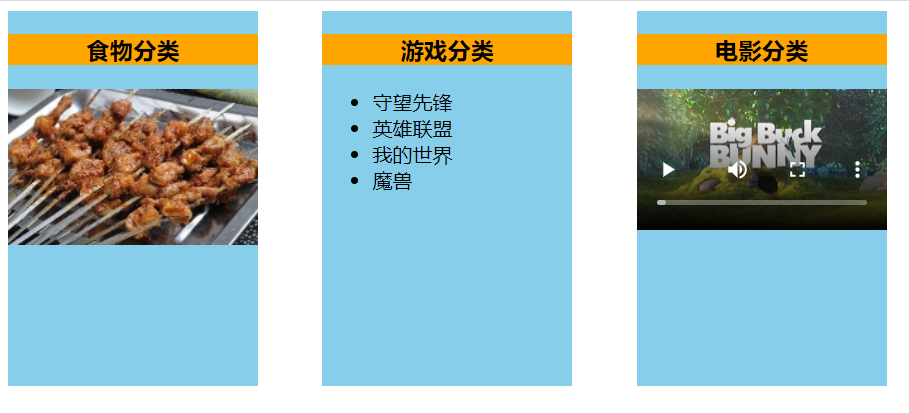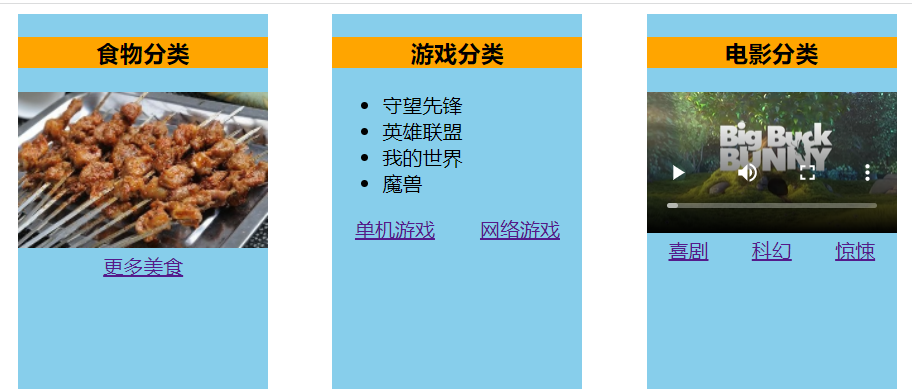初学Vue
插槽
1、作用
让父组件可以向子组件指定位置插入html结构,也是一种组件间通信的方式,适用于父组件===>子组件
2、分类和使用方式
- 默认插槽
父组件中:
<Category>
<div>html结构1</div>
<Category>
子组件中:
<template>
<div>
<!-- 定义插槽 -->
<slot>插槽默认内容</slot>
</div>
</template>
- 具名插槽:
父组件中:
<Category>
<template slot="center">
<div>html结构1</div>
</template>
<template v-slot="footer">
<div>html结构2</div>
</template>
<Category>
子组件中:
<template>
<div>
<!-- 定义插槽 -->
<slot name="center">插槽默认内容</slot>
<slot name="footer">插槽默认内容</slot>
</div>
</template>
- 作用域插槽
1、数据在组件自身1,但根据数据生成的结构需要组件的使用者来决定。
2、具体使用代码:
父组件中:
<Category>
<template scope="scopeData">
<!--生成的是ul列表-->
<ul>
<li v-for="g in scopeData.games" :key="g">{{g}}</li>
</ul>
<template>
<Category>
<Category>
<template slot-scope="scopeData">
<!--生成的是h4标题-->
<h4 v-for="g in scopeData.games" :key="g">{{g}}
</h4>
</template>
<Category>
子组件中:
<template>
<div>
<!-- 定义插槽 -->
<slot :games="games"></slot>
</div>
</template>
<script>
// 子组件中的数据
export default{
name:"Category",
props:['title'],
// 数据在子组件本身
data(){
return {
games:[...]
}
}
}
</script>
4、样例
例如,我们向下面图示中文字部分的内容通过插槽用图片和视频代替。

默认插槽
默认插槽相当于挖一个没有名字的坑(slot),等你往里面放入内容。(并且只能挖一个坑,但这个坑能填很多内容)
- App.vue
<template>
<div class="container">
<Category title="食物">
<img src="https://s3.ax1x.com/2021/01/16/srJlq0.jpg" alt="" />
</Category>
<Category title="游戏">
<ul>
<li v-for="(g, index) in games" :key="index">{{ g }}</li>
</ul>
</Category>
<Category title="电影">
<video src="http://clips.vorwaerts-gmbh.de/big_buck_bunny.mp4" controls></video>
</Category>
</div>
</template>
<script>
import Category from "./components/Category.vue";
export default {
name: "App",
components: { Category },
data() {
return {
foods: ["火锅", "烤全羊", "小龙虾", "手抓饭"],
games: ["守望先锋", "英雄联盟", "我的世界", "魔兽"],
films: ["阿凡达", "复仇者联盟", "侏罗纪世界", "魔兽世界"],
};
},
};
</script>
<style lang="css">
.container {
display: flex;
justify-content: space-around;
}
img {
width: 100%;
}
video {
width: 100%;
}
</style>
- Category.vue
<template>
<div class="category">
<h3>{{title}}分类</h3>
<slot></slot>
</div>
</template>
<script>
export default {
name:"Category",
props:['title']
}
</script>
<style>
.category{
width: 200px;
height:300px;
background-color: skyblue;
}
h3{
background-color: orange;
text-align: center;
}
</style>
效果图如下:

具名插槽
具名插槽相当于挖一个坑,但你可以给这个坑起名字,并且用和这个坑名字相同的内容来填坑。这样名字不同就意味着可以有很多个坑。
- App.vue
<template>
<div class="container">
<Category title="食物">
<img slot="center" src="https://s3.ax1x.com/2021/01/16/srJlq0.jpg" alt="" />
<div slot="footer" class="foods">
<a href="#">更多美食</a>
</div>
</Category>
<Category title="游戏">
<ul slot="center">
<li v-for="(g, index) in games" :key="index">{{ g }}</li>
</ul>
<div class="otherGames" slot="footer">
<a href="#">单机游戏</a>
<a href="#">网络游戏</a>
</div>
</Category>
<Category title="电影">
<video slot="center" src="http://clips.vorwaerts-gmbh.de/big_buck_bunny.mp4" controls></video>
<div slot="footer" class="filmsTypes">
<a href="#">喜剧</a>
<a href="#">科幻</a>
<a href="#">惊悚</a>
</div>
</Category>
</div>
</template>
<script>
import Category from "./components/Category.vue";
export default {
name: "App",
components: { Category },
data() {
return {
foods: ["火锅", "烤全羊", "小龙虾", "手抓饭"],
games: ["守望先锋", "英雄联盟", "我的世界", "魔兽"],
films: ["阿凡达", "复仇者联盟", "侏罗纪世界", "魔兽世界"],
};
},
};
</script>
<style lang="css">
.container {
display: flex;
justify-content: space-around;
}
img {
width: 100%;
}
video {
width: 100%;
}
.foods{
text-align: center;
}
.otherGames{
display: flex;
justify-content: space-around;
}
.filmsTypes{
text-align: center;
display: flex;
justify-content: space-around;
}
</style>
- Category.vue
<template>
<div class="category">
<h3>{{title}}分类</h3>
<!-- slot标签中可以添加内容,表示默认值 -->
<slot name="center">中间部分</slot>
<slot name="footer">底部部分</slot>
</div>
</template>
<script>
export default {
name:"Category",
props:['title']
}
</script>
<style>
.category{
width: 200px;
height:300px;
background-color: skyblue;
}
h3{
background-color: orange;
text-align: center;
}
</style>
效果图如下:

作用域插槽
- App.vue
<template>
<div class="container">
<Category title="游戏">
<template scope="recieveDatas">
<!-- {{recieveDatas.games}} -->
<!--recieveDatas是一个对象,games是其下的一个内容-->
<ul slot="center">
<li v-for="(g, index) in recieveDatas.games" :key="index">{{ g }}</li>
</ul>
</template>
</Category>
<Category title="游戏">
<template slot-scope="recieveDatas">
<ol slot="center">
<li v-for="(g, index) in recieveDatas.games" :key="index">{{ g }}</li>
</ol>
</template>
</Category>
<Category title="游戏">
<template slot-scope="recieveDatas">
<h4 v-for="(g, index) in recieveDatas.games" :key="index">{{ g }}</h4>
</template>
</Category>
</div>
</template>
<script>
import Category from "./components/Category.vue";
export default {
name: "App",
components: { Category },
};
</script>
<style lang="css">
.container {
display: flex;
justify-content: space-around;
}
</style>
- Category.vue
<template>
<div class="category">
<h3>{{ title }}分类</h3>
<!-- slot标签中可以添加内容,表示默认值 -->
<slot :games="games">中间部分</slot>
</div>
</template>
<script>
export default {
name: "Category",
props: ["title"],
data() {
return {
games: ["守望先锋", "英雄联盟", "我的世界", "魔兽"]
};
},
};
</script>
<style>
.category {
width: 200px;
height: 300px;
background-color: skyblue;
}
h3 {
background-color: orange;
text-align: center;
}
</style>
效果图如下:

补充:
(1)和其他两种插槽方式相比,作用域插槽逻辑性更强。
(2)且就像其名一样,只在作用域范围内数据生效,这个作用域范围指的是你数据定义在哪个组件,那么你就只能在哪个组件上使用该数据。
(3)但有一种方式,即在<slot :xxxx="xxxx">中间部分</slot>标签上将数据类似props一样传输,在另一个组件上通过<template scope="xxx"> </template>可以获取到该组件上的数据,其中xxx就是接收到的数据(是一个对象,通过xxx.数据就可以使用数据了)。(xxx和xxxx的名字是可以不同的)
(4)作用域插槽必须使用template标签包裹
(5)template标签中的属性可以使用scope,也可以使用slot-scope,只是后者版本更新
组件自身是指使用插槽< slot></ slot>的那个组件。 ??